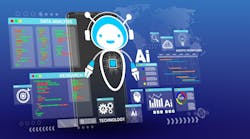Whether it’s a Snickers bar providing you with an afternoon pick-me-up or a bag of Pedigree to feed your furry friend, chances are one of the many Mars products or services touches your daily life. And, for good reason. The 100+ year old, $40 billion, family-owned organization has built a solid reputation for its wide-reaching array of consumer goods and services.
Maintaining its status as a world-class manufacturer and service provider plays a meaningful role in staying relevant, especially in highly competitive markets. As such, Mars embarked on a digital transformation journey roughly three and a half years ago with the goal of instilling agility into the business and moving towards a truly digital first future.
In spearheading the ongoing transformation, Sandeep Dadlani, chief digital officer for Mars, divides the comprehensive process into three broad layers:
“These three layers ladder up to the company's digital vision, which is to go 100x faster. It's been a remarkable journey in terms of making those investments and driving change in talent, capabilities and business models," he says.
Simply put, the approach is working.
In the last 14 months alone, Mars has brought about manifestations of its digital efforts by launching 18+ D2C commerce campaigns. For instance, Mars leveraged Microsoft Teams to initiate a telehealth service enabling pet owners to conduct video-based consultations with vets in pet hospitals run by Mars Petcare.
Also, tapping into a relationship with Microsoft partner Transparency-One, Mars was able to create transparency in the rice supply chain, enabling consumers access to information about which farmer provided their rice came. “These are issues very important to our consumers,” he says.
Obviously, the goal is to keep the successes coming. With a dedicated Innovation Lab, Mars plans to continue its digital evolution by evaluating, piloting, and incorporating additional technologies that capable of transforming workplaces and increasing the digital skills of associates. “By driving greater efficiency and effectiveness, we’re giving our associates the gift of time to focus on what they do best. And we’ll do so faster than ever — reducing time to market to weeks, rather than months or even years,” says Dadlani.
Mars is also accelerating intelligent supply chain efforts, including scaling digital manufacturing and expanding the use of AI and data solutions to create smarter factories. This includes everything from a 1% savings on confectionery products to improved quality control.
Finally, the recently announced relationship with Microsoft emphasizes sustainable growth by reducing the company’s carbon impact in the transition to a cloud-first strategy. “We’ll also work to reduce waste during the manufacturing process by driving technological efficiencies,” he says.
Pandemic impact
When the pandemic hit, Mars was fortunate its products and services were always in demand, some of which surfaced as essential services. “Our first and only priority was the safety of our associates. This is also where data and analytics came into play,” he says. “We could use advanced AI and analytics to really plan the reopening of our factories layout.”
One hurdle that many manufacturers faced was getting products to customers-an area where digital technologies opened doors. When traditional channels were not open, Mars enabled WhatsApp ordering overnight. It also had a D2C launch where consumers could donate Snickers boxes for frontline workers who arguably after a long day “needed a break.”
The question going forward: How does the company maintain the same level of empathy for its associates and consumers, while driving the same speed post pandemic?
“It means putting forth a dramatic increase in clock speed and decision-making speed,” says Dadlani.
Sweet successes
The development of industry leading analytic capabilities has proven instrumental in driving better pricing, better revenue management, better product assortment, and better routes to market. “Digital capabilities have made us more competitive in getting our products and services to the market,” he says.
The transformation has also helped provided the company with the agility necessary to completely rethink offerings on the fly. Halloween 2020 serves as a good Covid-19 example since trick or treating looked completely different. “Our digital platform Treat Town enabled consumers to decorate their own door virtually and trick-or-treat with grandma in Alaska or an uncle in Florida,” he says. “This quick launch helped us to rethink how we could take this platform to other festivities in the future such as Easter or Christmas. We've launched new business models, per se, every month through these new digital capabilities.”
However, perhaps the biggest success has been in how well the associates have embraced the transformation. “It was our vision that every associate should feel that Mars is one of the best places to work in the world. And, when digitally enabled, our associates should feel empowered to be a superhero and get things done,” said Dadlani. “In our factories, we now have associates using an array of devices, enabled either on Microsoft Teams or on HoloLens, for line changes that allow them to be more efficient.”
Plus, roughly 30,000 Mars associates are trained on data visualization techniques and 17,000 associates are trained in design thinking and user-centricity. In December the company also hosted a Mars AI festival for 133,000 associates to celebrate 200+ AI use cases at scale. “This speaks to the unique culture at Mars and the vision the leadership team has in truly embedding digital into everything we do,” he says.
The keys to achieving these successes at Mars – having a vision to invest in digital, a uniquely human-centric culture and a longstanding focus on science have been pivotal. “Even before this digital transformation Mars has always been a science-based company with a prevalence of science and evidence in everything we do,” he says. “Having these ingredients in place means digital experts can come in and help drive a human centric revolution versus just a technology or tools-based revolution.”
Of course, while it's important to celebrate the successes, Dadlani acknowledges the value in learning from failures is equally important. It is also important to recognize that change is difficult, even for the most earnest associates. “These are different ways of thinking and doing things. Perhaps that change, then leads to us really taking our talent level to the next level,” he says. “Change is always the most challenging aspect, but given the culture, leadership and nature of Mars, I find this to be more fertile ground than most.”
Problems first
When selecting technologies to push the transformation forward, the Mars approach is to start by focusing on finding the problem as close to the consumer as possible. “Understanding how they feel about the experience provides clarity on any problem you need to solve. If you can solve it through a simple technology, that's okay. Not everything needs an AI level sophisticated solution,” he says.
Unfortunately, not many companies frame the problems well. “There needs to be a focus around user centricity, design thinking and correct problem framing. Once that is done, turning to amazing strategic partners like Microsoft can quickly yield solutions,” he says. “We feel good about leveraging Microsoft as a primary cloud partner, data partner as well integration partner.”
Dadlani has identified the deployment of digital twins as a crucial technology going forward. With a goal of digitizing 160 factories across 88 countries, the rollout will undoubtedly take time.
Mars has a one of the most sophisticated manufacturing setups in the world, explains Dadlani. “With that comes our ability to plan our factories including: the production and downtime of machines, simulating how these machines work; how much raw material is needed to produce the right output,” he says.
The ability to focus on quality is a prime example of where Mars is turning to its digital twins. One example – controlling the precise amount of product going into a bag of Skittles or M&Ms. “We want the consumer to get the exact amount of product expected, avoiding the potential problem of consumer disappointment. It helps avoid wastage, of excess product,” he says. “The business case and the problems we are trying to solve become clear and worth simulating the use of sensors and technologies on those machines to precisely calibrate the amount of product in a bag.”
As Dadlani’s team rolls out the digital twins, the use cases are literally churning out by the day. “We also found a partnership that will allow us to digitize the factories, not just for the sake of digitization, but for solving the specific problems,” he says. Over time, it will provide a library of use cases where factories can choose from the problems already solved in previous deployments.
Bottom line: “Mars is hurtling towards a future where we will have to reimagine our business models to be digital first at every level. This movement allows us to bring the best of both the human side and the digital possibilities of the future together in collective reimagining of our business models,” he says. “I hope it inspires our associates, partners like Microsoft and frankly the industry to build a better tomorrow, today.”






